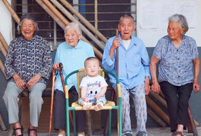 Happy life in Xinjiang
Happy life in Xinjiang
 2014 China Hainan Int'l Automotive Exhibition kicks off
2014 China Hainan Int'l Automotive Exhibition kicks off
 Collection of 'China Dream' public-spirited ads
Collection of 'China Dream' public-spirited ads
 The silent holy stones
The silent holy stones
 University students take care of giant pandas
University students take care of giant pandas
 Leading lady a true legend
Leading lady a true legend
 China Pan-Asia Stone Expo held in Kunming
China Pan-Asia Stone Expo held in Kunming
 Taiwan woman marries into Kazak family, 100 sheep plus a flat as dowry
Taiwan woman marries into Kazak family, 100 sheep plus a flat as dowry
 College girls take graduation photos under water in Chongqing
College girls take graduation photos under water in Chongqing
 Cartoon: Xi and football
Cartoon: Xi and football
BEIJING, July 13 -- Although Chinese leaders have stressed the flexibility of the GDP growth target, an inspection group dispatched by the State Council found that attaining "reasonable" growth remains a struggle.
The group inspected government work in Hebei, Liaoning, Heilongjiang and Beijing from June 25 to July 5. It noted that slowed economic growth, particularly in Hebei and Heilongjiang, needs to be addressed.
Hebei Province's GDP growth fell by 4 percentage points to 4.2 percent in the first quarter, marking the worst performance in the past 20 years.
Hebei, which borders Beijing, is making painstaking efforts to cut cement, steel and glass facilities as the province is partly blamed for the smog in the Chinese capital.
These polluting facilities, however, are the major powerhouse driving Hebei's economy.
The economy in northeast China's Heilongjiang Province also suffered a heavy blow in the first three months with GDP expansion decelerating to 4.1 percent from 9 percent in the first quarter of 2013. Its growth was the lowest of China's provincial-level regions.
Oil exploitation, coal mining and lumber, the three pillars of Heilongjiang's economy, shrank quickly due to low energy prices and strict felling bans.
The inspection group found that although the economy in Liaoning Province was generally stable, it suffered from weak exports and low investment enthusiasm, especially in the property market.
The group said in a report that secondary industry plays a decisive role in the economy in these provinces. An unbalanced economic structure leaves them vulnerable to macroeconomic fluctuation.
Like Hebei, Heilongjiang and Liaoning, China's other provinces are confronted with downward pressure as the country adapts to an economic slowdown and reshuffles the economic structure.
For the first time, China set a flexible GDP target of around 7.5 percent for this year and came up with the term "reasonable range," giving GDP growth more room to fall.
Although there is no specific lower limit to the range, an abruptly stalled economy could lead to rising unemployment, less government spending on improving livelihood, and even social unrest.
Yang Chuantang, head of the inspection group, said he thought the growth rate in Heilongjiang and Hebei fell out of the reasonable range in the first quarter.
"If pro-growth measures do not kick in immediately, it will be very hard for them to secure the yearly target," he added.
 |
 How Chinese men kill the time when their wives practice square dancing?
How Chinese men kill the time when their wives practice square dancing? Chinese Navy frogmen in training: photos
Chinese Navy frogmen in training: photos Lishui, city of longevity with 186 healthy men above 100 years old
Lishui, city of longevity with 186 healthy men above 100 years old Hong Kong Fashion Festival kicks off
Hong Kong Fashion Festival kicks off Germany crush Brazil to advance to World Cup final
Germany crush Brazil to advance to World Cup final Danish badminton team plays Chinese social media users on Asia tour
Danish badminton team plays Chinese social media users on Asia tour Art on eggshells
Art on eggshells Test flight of Russian amphibian BE-103 in Shenyang, NE China
Test flight of Russian amphibian BE-103 in Shenyang, NE China Stewardesses of CHR trains experience walk with white cane
Stewardesses of CHR trains experience walk with white cane Picturesque Bashang Prairie through lens
Picturesque Bashang Prairie through lens 'Finding Nemo' in Seattle Aquarium
'Finding Nemo' in Seattle Aquarium 28 old villages in Hunan under preservation
28 old villages in Hunan under preservation Anti-terrorism drills held in Luliang, Shanxi province
Anti-terrorism drills held in Luliang, Shanxi province Hot weather drives citizens to play mahjong in water
Hot weather drives citizens to play mahjong in water Largest domestic UAV exhibition held in Beijing
Largest domestic UAV exhibition held in BeijingDay|Week|Month